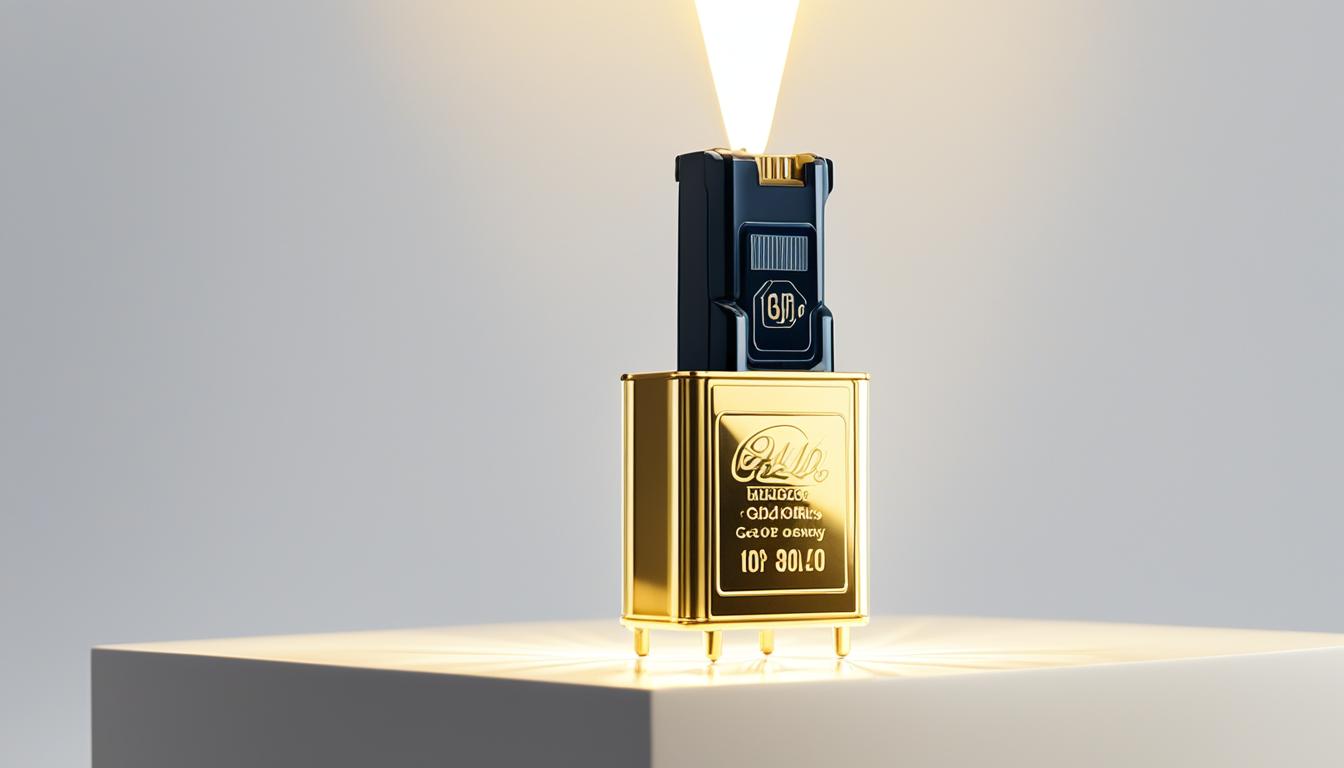Printer ink can often be more expensive than the printers themselves, and you may wonder why. There are several factors that contribute to the higher cost of ink, including research and development, the business model adopted by printer manufacturers, ink wastage, limited availability, and low competition. Let’s explore these factors in detail to understand why ink prices can be so high.
Key Takeaways:
- Printer ink is more expensive than printers due to various factors.
- Printer manufacturers invest in research and development to create high-quality ink.
- The “razor and blades” business model allows manufacturers to profit from ink sales.
- Ink wastage during maintenance tasks can contribute to higher ink consumption and costs.
- The limited availability of compatible inks and low competition contribute to high prices.
The Cost of Ink Research and Development
Ink technology plays a crucial role in producing high-quality prints with vibrant colors and sharp details. However, the development of such advanced ink formulations involves extensive research and development and the use of premium materials. This commitment to ink technology contributes to the higher cost of genuine OEM ink cartridges.
Printer manufacturers, like HP, invest significant resources in researching and formulating inks with the perfect mixture of dyes, pigments, and other ingredients. The goal is to create reliable ink that is clog-free, color-accurate, and resistant to heat, water, and abrasion.
“We are dedicated to providing our customers with the best possible print quality,” says John Thompson, Head of Research and Development at HP. “Our ink research involves rigorous pre-release testing and collaborating with specialized teams to ensure optimal performance in various printing scenarios.”
Research and development efforts also focus on developing ink formulations that can withstand the demands of different printing technologies. For instance, pigment-based inks are commonly used in high-quality photo printers to produce rich and long-lasting prints, while dye-based inks are preferred for general-purpose document printing.
By continuously investing in ink technology, printer manufacturers strive to deliver excellent print quality, ensuring that every image or document produced meets the highest standards. This commitment to innovation and premium ink formulations justifies the higher cost associated with genuine OEM ink cartridges.
The Benefits of Premium Ink
Premium ink is designed to exceed expectations and provide superior results compared to cheaper alternatives. Incorporating advanced technology and carefully selected ingredients, premium ink offers the following benefits:
- Enhanced Color Accuracy: Premium ink cartridges are meticulously calibrated to reproduce colors with exceptional accuracy, ensuring that prints reflect the true hues of the original image.
- Water and Fade Resistance: Top-quality ink is formulated to resist water and fading, allowing prints to maintain their vibrancy and longevity even when exposed to moisture or direct sunlight.
- Quick Drying: Premium ink dries quickly, reducing the risk of smudging and ensuring that prints can be handled immediately without compromising their quality.
- Clog-Free Performance: The advanced formulation of premium ink minimizes the risk of clogs, ensuring consistent and reliable printing results throughout the life of the cartridge.
When it comes to achieving exceptional print quality and long-lasting results, investing in premium ink cartridges is undoubtedly worth considering.
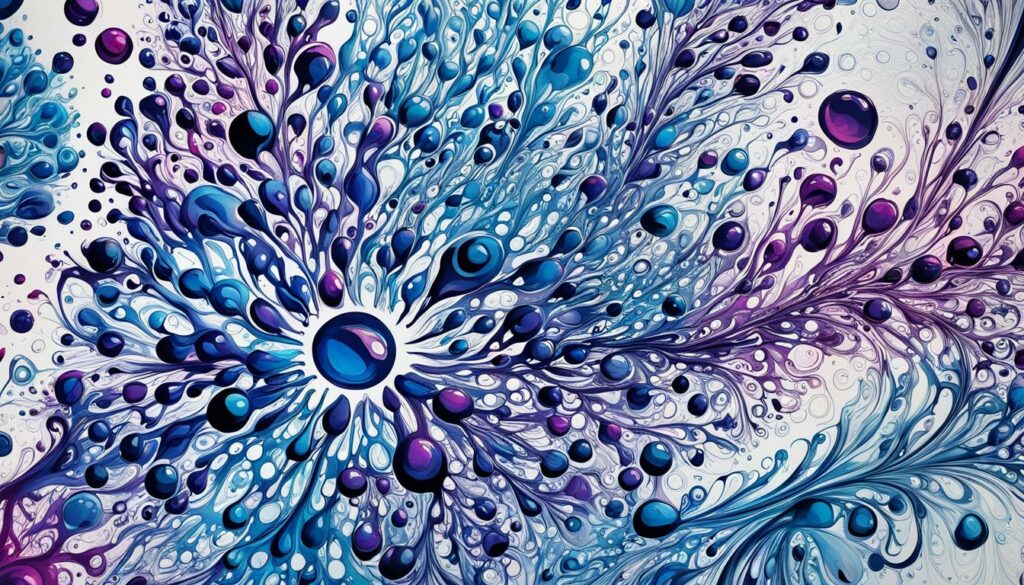
No matter the cost, the quality and reliability of genuine OEM ink cartridges make them the preferred choice for professional photographers, graphic designers, and businesses that rely on high-quality prints in their day-to-day operations. However, for those seeking more affordable options without compromising print quality, there are alternative ink cartridges available in the market.
The Razor and Blades Business Model
One of the key factors contributing to the higher cost of printer ink is the razor and blades business model employed by printer manufacturers. Under this model, printers are often sold at a low cost or even at a loss, while ink cartridges are priced higher to compensate for the printer’s affordability. This strategy allows manufacturers to generate profits from the sale of accompanying accessories, particularly ink cartridges.
The printer manufacturers strategically control ink technology and prices to maximize their revenue from ink cartridge sales. They enforce ink cartridge authentication systems, limiting the use of third-party inks and ensuring that consumers purchase ink directly from the manufacturer. By implementing these authentication measures, printer manufacturers can maintain control over the pricing and quality of ink cartridges, ultimately boosting their profits.
Furthermore, the sales of ink cartridges and other accessories, rather than the printers themselves, generate a significant portion of the revenue for printer manufacturers. While printer pricing may seem attractive to customers, the ongoing purchase of ink cartridges becomes a recurring expense that contributes to the overall cost of owning and using a printer.
Printer manufacturers have embraced the razor and blades business model, understanding the high demand for printer accessories, particularly ink cartridges. By selling printers at low prices and capitalizing on the subsequent sales of ink cartridges, they create a profitable cycle that keeps customers reliant on their products and genuine OEM ink.
Printer pricing plays a crucial role in the effectiveness of the razor and blades business model. Lower printer prices attract customers, leading to increased accessory sales. In this case, the primary accessory is ink cartridges. Printer manufacturers offer a wide range of ink cartridges tailored to their specific printer models. These cartridges are engineered to optimize print quality and ensure compatibility with the printers, further reinforcing the need for customers to purchase genuine OEM ink cartridges.
In summary, the razor and blades business model adopted by printer manufacturers enables them to sell printers at lower prices while generating revenue from the sale of ink cartridges and other accessories. By controlling ink technology and implementing ink cartridge authentication, they maintain a steady stream of accessory sales and increase their profits. This model impacts printer pricing and enhances the importance of choosing compatible ink cartridges, as they are an ongoing expense for printer owners.
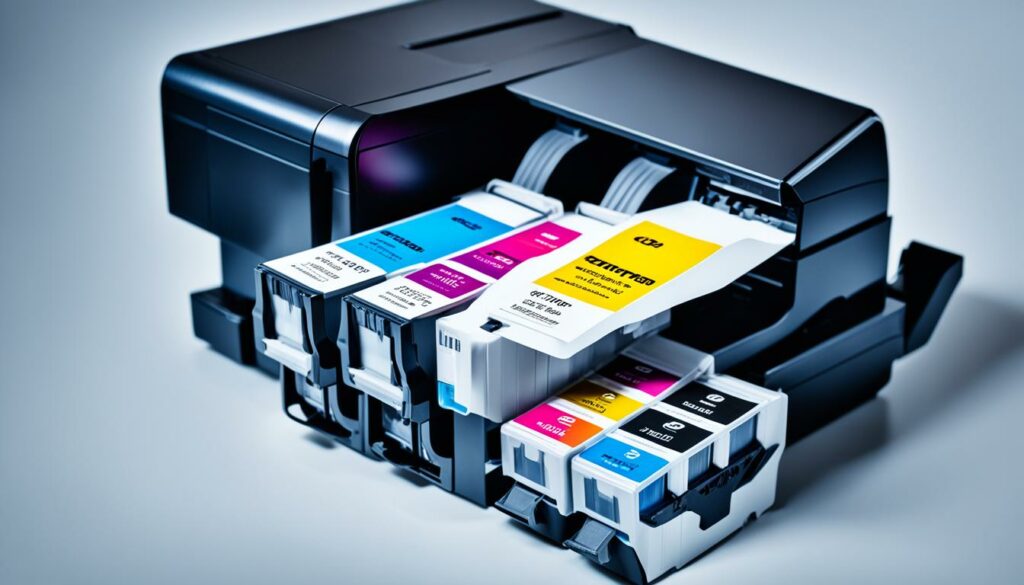
Printer Pricing Comparison
| Printer Brand | Printer Model | Printer Price |
|---|---|---|
| Brand A | Model X | $99 |
| Brand B | Model Y | $149 |
| Brand C | Model Z | $79 |
Ink Wastage and Printer Maintenance
Printer inks serve not only for printing documents but also for essential maintenance tasks, including printhead cleaning. However, some printers can consume a significant amount of ink during these maintenance tasks, resulting in higher ink consumption and costs. To mitigate ink wastage and reduce unnecessary expenses, printer users should adopt more efficient printing practices.
To start, it’s crucial to understand the specific maintenance tasks that require ink consumption. Printers typically initiate automated printhead cleaning cycles to unclog nozzles and ensure optimal print quality. While important for proper printer functioning, these cleaning cycles use additional ink. Constant and unnecessary cleaning cycles can lead to substantial ink wastage and increased expenses.
One way to minimize ink wastage is to adjust the printer settings. Printers often offer different quality settings for printing documents. Choosing the appropriate setting for each print job can help optimize ink usage. For example, draft mode or eco mode utilizes less ink, making it suitable for internal drafts or documents that do not require high-quality output.
Regular maintenance is also essential to prevent excessive printhead clogging, which can result in poor print quality. Engaging in routine manual cleaning of the printhead can help maintain ink flow and reduce the need for frequent automated cleaning cycles. However, it is crucial to follow the manufacturer’s guidelines and recommendations for manual cleaning to avoid damaging the printer.
Additionally, staying proactive about general printer maintenance can contribute to efficient ink usage. Keeping the printer clean and free from dust and debris can prevent potential printhead clogs, reducing the frequency of automated cleaning cycles. Regularly checking and replacing ink cartridges promptly when needed can also help prevent ink wastage caused by dried or expired cartridges.
“Efficient printer maintenance and optimized ink usage can significantly impact overall printing expenses and minimize ink wastage.”
By adopting these practices, users can effectively reduce ink wastage during printer maintenance tasks while maximizing the lifespan of ink cartridges. Implementing efficient ink usage habits not only helps save costs but also contributes to a more sustainable printing environment.
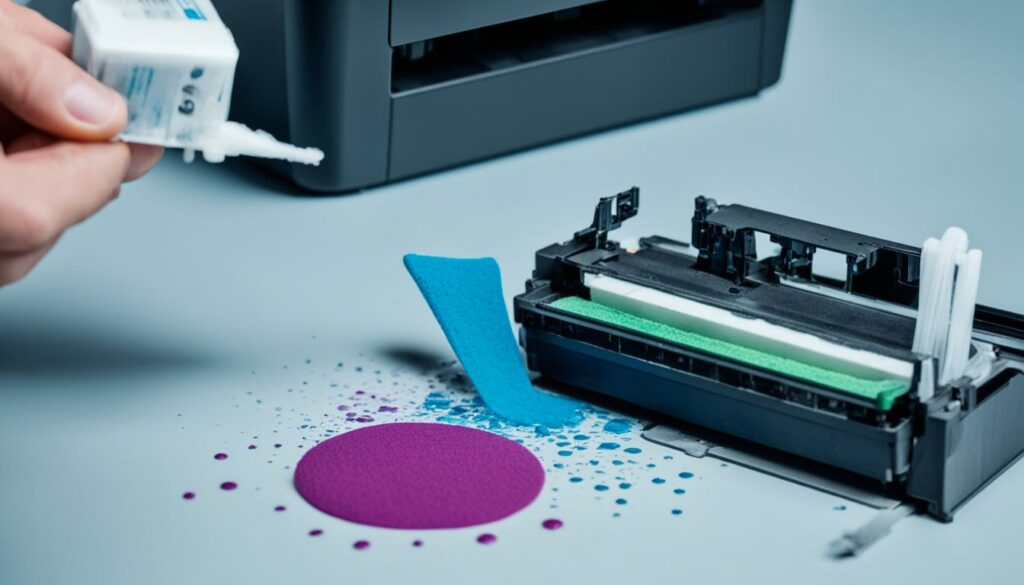
| Effective Practices to Reduce Ink Wastage | Benefits |
|---|---|
| Adjust printer settings to optimize ink usage | – Reduce ink consumption during print jobs – Lower printing costs |
| Engage in routine manual printhead cleaning | – Minimize clogs and maintain print quality – Reduce reliance on automated cleaning cycles |
| Maintain a clean printer free from dust and debris | – Prevent printhead clogs and unnecessary cleaning cycles – Extend the lifespan of ink cartridges |
| Regularly check and replace ink cartridges when needed | – Avoid ink wastage from dried or expired cartridges – Ensure optimal print quality |
Limited Availability and Low Competition
The high prices of printer ink can be attributed to the limited availability of compatible inks and the low competition among manufacturers. Each printer model requires specific ink cartridges, which restricts the options for compatible alternatives. This lack of competition allows printer manufacturers to maintain higher prices for their genuine OEM ink cartridges.
The Challenge of Finding Compatible Inks
When it comes to purchasing ink cartridges, printer users often face the challenge of finding compatible options. Unlike major printer brands’ proprietary cartridges, compatible inks are produced by third-party manufacturers and offer a more cost-effective alternative. However, due to the variations in printer models, finding the exact match for a specific printer can be difficult.
Since printer manufacturers usually design their printers to work exclusively with their branded cartridges, compatibility issues arise with third-party options. Printer users may encounter compatibility errors, poor print quality, or even damage to the printer itself when using non-OEM cartridges. As a result, many users opt to purchase genuine OEM cartridges.
The Impact of Low Competition
The limited competition among printer ink manufacturers also contributes to the higher prices. With fewer companies producing ink cartridges for each specific printer model, the lack of competition allows manufacturers to maintain higher price points for their genuine OEM cartridges. This monopolistic control over ink cartridges gives manufacturers the power to set prices without the need for price competition.
“The limited availability of compatible inks and the low competition among manufacturers have resulted in higher prices for printer ink cartridges. This situation puts the consumers at a disadvantage, forcing them to choose between genuine OEM cartridges at higher costs or risking compatibility and print quality issues with third-party options.”
Despite the challenges, some third-party manufacturers have successfully developed compatible ink cartridges that provide reliable performance and compatibility with specific printer models. These compatible options offer cost savings to consumers who are willing to explore alternatives to the higher-priced genuine OEM cartridges.
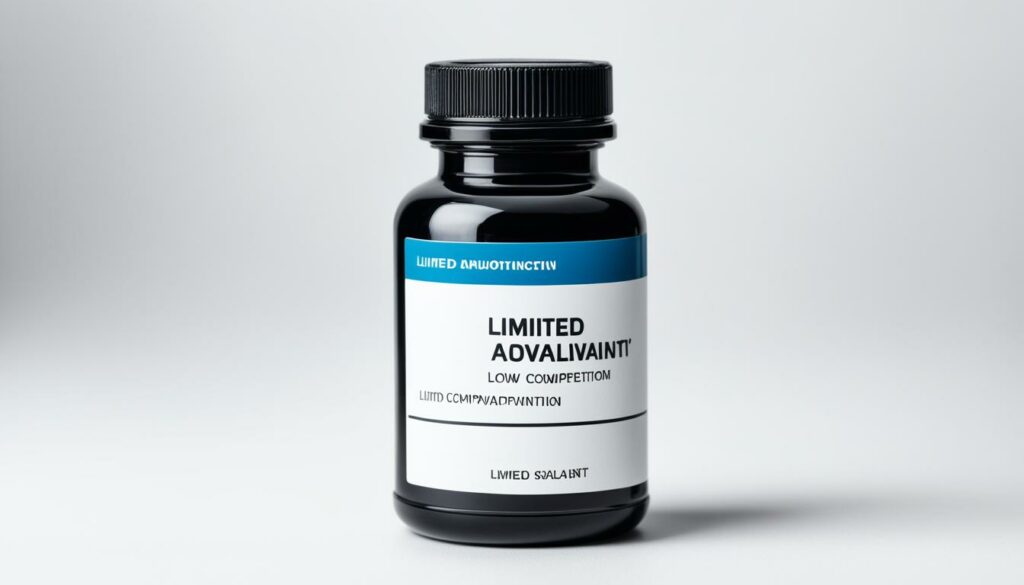
Saving Money on Printer Ink
When it comes to purchasing printer ink, there are alternatives that can help you save money without compromising on print quality. By considering cheaper ink options, such as compatible cartridges and refilled cartridges, you can reduce your printing expenses significantly.
Compatible cartridges are third-party ink cartridges that are designed to work with your specific printer model. These cartridges are often significantly cheaper than genuine OEM ink cartridges. They are not considered counterfeit and can provide acceptable print quality for regular printing tasks.
Refilled cartridges are another cost-effective option. These cartridges are original ink cartridges that have been carefully cleaned, refilled, and tested before being resold. By opting for refilled cartridges, you not only save money but also contribute to a more sustainable printing practice.
It’s important to note that while compatible and refilled cartridges can offer cost savings, they may not always provide the same print quality as genuine OEM ink cartridges. However, for everyday printing needs, they can be a reliable and budget-friendly choice.
“By considering cheaper alternatives like compatible cartridges and refilled cartridges, users can save money on printer ink without compromising on print quality.”
Comparing Cost Savings: Genuine OEM vs. Compatible vs. Refilled Cartridges
| Cartridge Type | Price | Print Quality |
|---|---|---|
| Genuine OEM Cartridges | Higher Price | High-Quality Prints |
| Compatible Cartridges | Cheaper | Acceptable Print Quality for Regular Tasks |
| Refilled Cartridges | Cheaper | Acceptable Print Quality for Regular Tasks |
As shown in the table above, genuine OEM cartridges come with a higher price tag but offer high-quality prints. On the other hand, compatible and refilled cartridges provide a more affordable alternative with acceptable print quality for regular printing needs. When deciding which option to choose, consider your specific printing requirements and budget constraints.
By exploring these cheaper ink options, you can effectively reduce your printing costs while still achieving satisfactory results. Whether you opt for compatible cartridges or refilled cartridges, these alternatives can help you save money without compromising on the quality of your prints.

Tips for Efficient Printing
To make printing more budget-friendly, there are several tips that consumers can follow to optimize their printing process. Here are some recommendations for efficient printing:
- Choose the right printer: Selecting the appropriate printer for your needs can significantly impact your printing costs. Inkjet printers are generally more suitable for home and small business printing, while laser printers are better suited for high-volume printing in larger offices.
- Evaluate your printing needs: Assessing your printing requirements helps in determining the most cost-effective options. For less important documents, consider using the draft mode to conserve ink and reduce costs.
- Explore cheaper ink and cartridge options: Third-party cartridges, also known as compatible cartridges, can be a cost-effective alternative to genuine OEM ink cartridges. These cartridges can offer similar print quality at a lower price point, providing substantial savings.
- Calculate the cost per page (CPP): Comparing the overall cost of different printer and ink cartridge options can be done by calculating the cost per page. Take into account the printer’s price, ink cartridge prices, and page yield to determine the most cost-effective choice.
By incorporating these tips into their printing practices, consumers can achieve budget-friendly printing without compromising on quality or efficiency.
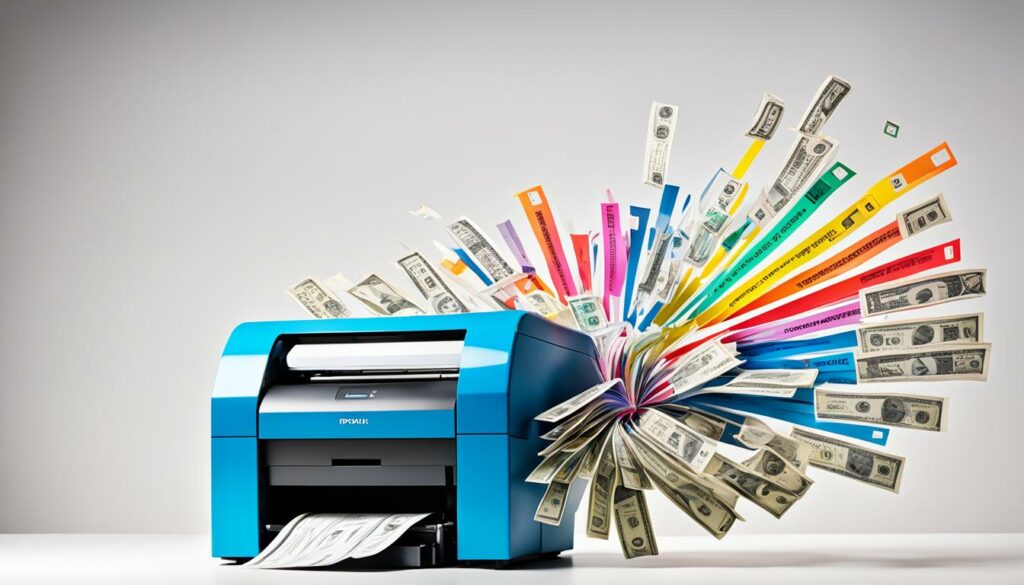
Remember, efficient printing involves making informed decisions when it comes to printer selection and ink cartridge choices. Taking the time to evaluate your needs and explore cost-effective alternatives can lead to substantial savings in the long run.
Conclusion
Printer ink pricing can be a significant expense for consumers, often surpassing the cost of the printers themselves. This is due to several factors, including the high cost of ink research and development, the “razor and blades” business model employed by printer manufacturers, ink wastage during maintenance tasks, limited availability of compatible inks, and the premium prices charged for OEM cartridges.
However, there are plenty of cost-saving tips and alternatives available to help consumers reduce their printer ink expenses. One option is to consider using third-party compatible cartridges, which can provide comparable print quality at a fraction of the cost of OEM cartridges. Additionally, refilled cartridges offer another affordable option for environmentally-conscious consumers.
Furthermore, selecting the right printer for your needs, evaluating your printing requirements, and calculating the cost per page can all contribute to long-term savings. By being mindful of printer ink pricing and exploring cost-saving strategies, consumers can enjoy high-quality prints without breaking the bank.
Source Links
- https://www.makeuseof.com/why-is-printer-ink-so-expensive-print-more-for-less/
- https://www.consumerreports.org/electronics-computers/printers/why-is-printer-ink-so-expensive-a2101590645/
- https://www.readersdigest.co.uk/lifestyle/technology/why-printer-ink-is-so-expensive-and-how-to-spend-less

Morgan Azhari, the owner of PrinterUpdate.net, is a dedicated expert in the field of printers, leveraging a wealth of experience and education to create a platform that passionately shares insights and solutions.
With a goal to enhance the printer user experience, my vision for the website is to provide valuable content, making a positive impact on individuals navigating the complexities of printers.
